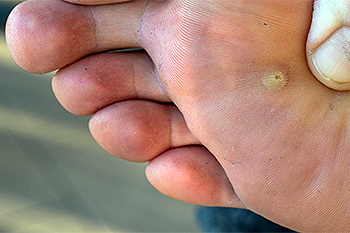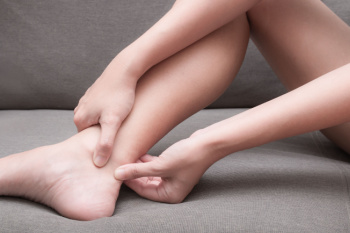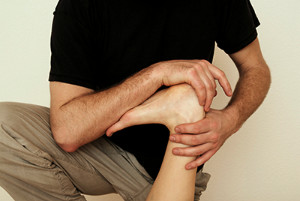
Plantar warts are small growths caused by the human papillomavirus, or HPV, that typically develop on the soles of the feet. They often appear as rough, grainy lesions with tiny black dots, which are clotted blood vessels. Symptoms can include discomfort or pain when walking or standing, especially if the wart is located over a weight-bearing area like the heel or ball of the foot. Plantar warts spread through direct contact with the virus, thriving in warm, moist environments like communal showers or swimming pools. The virus can enter the body through small cuts or breaks in the skin. Individuals with weakened immune systems or who walk barefoot in public places are more susceptible. If you have developed a plantar wart, it is suggested that you consult a podiatrist who can effectively treat this condition, which often includes in-office treatment.
Plantar warts can be very uncomfortable. If you need your feet checked, contact Brent Harwood, DPM from Southeast Podiatry. Our doctor will assist you with all of your foot and ankle needs.
About Plantar Warts
Plantar warts are the result of HPV, or human papillomavirus, getting into open wounds on the feet. They are mostly found on the heels or balls of the feet.
While plantar warts are generally harmless, those experiencing excessive pain or those suffering from diabetes or a compromised immune system require immediate medical care. Plantar warts are easily diagnosed, usually through scraping off a bit of rough skin or by getting a biopsy.
Symptoms
Treatment
To help prevent developing plantar warts, avoid walking barefoot over abrasive surfaces that can cause cuts or wounds for HPV to get into. Avoiding direct contact with other warts, as well as not picking or rubbing existing warts, can help prevent the further spread of plantar warts. However, if you think you have developed plantar warts, speak to your podiatrist. He or she can diagnose the warts on your feet and recommend the appropriate treatment options.
If you have any questions please feel free to contact one of our offices located in Fairhope, Brewton, and Atmore, AL . We offer the newest diagnostic and treatment technologies for all your foot and ankle needs.

In the world of dance and sports, foot injuries are unfortunately common but manageable with proper care. Dancers, in particular, are prone to conditions like stress fractures, tendonitis, and ankle sprains due to repetitive movements and intense physical demands. These injuries often stem from overuse, improper technique, or inadequate footwear. Relief typically involves gentle stretching and strengthening exercises. However, an accurate diagnosis and targeted treatment plans are key, making a podiatrist's expertise invaluable. This type of foot doctor can offer specialized care and recommend strategies tailored to a dancer's unique needs. If you are experiencing persistent pain or suspect a foot injury, a podiatrist can help you recover effectively and safely, ensuring you can return to your passion for dance with confidence and reduced risk of recurrence. It is suggested that you schedule an appointment with a podiatrist today.
Ankle and foot injuries are common among athletes and in many sports. They can be caused by several problems and may be potentially serious. If you are feeling pain or think you were injured in a sporting event or when exercising, consult with Brent Harwood, DPM from Southeast Podiatry. Our doctor will assess your condition and provide you with quality foot and ankle treatment.
Common Injuries
The most common injuries that occur in sporting activities include:
Symptoms
Symptoms vary depending upon the injury and in some cases, there may be no symptoms at all. However, in most cases, some form of symptom is experienced. Pain, aching, burning, bruising, tenderness, tightness or stiffness, sensation loss, difficulty moving, and swelling are the most common symptoms.
Treatment
Just as symptoms vary depending upon the injury, so do treatment options. A common treatment method is known as the RICE method. This method involves rest, applying ice, compression and elevating the afflicted foot or ankle. If the injury appears to be more serious, surgery might be required, such as arthroscopic or reconstructive surgery. Lastly, rehabilitation or therapy might be needed to gain full functionality in the afflicted area. Any discomfort experienced by an athlete must be evaluated by a licensed, reputable medical professional.
If you have any questions, please feel free to contact one of our offices located in Fairhope, Brewton, and Atmore, AL . We offer the newest diagnostic and treatment technologies for all your foot care needs.

If you think you might be a candidate for bunion surgery, here are key factors to help guide your decision. Bunions are painful bumps on the side of your big toe that develop when the base of the toe pushes outward. Bunion formation is often due to genetics and wearing ill-fitting shoes, particularly high heels. Bunion pain can be managed through various non-surgical treatments such as wearing supportive shoes, and having pain medications or cortisone shots. If these methods fail and the bunion severely impacts your daily life, surgery becomes an option. The type of surgical procedure depends on the severity of the bunion, with moderate cases typically involving shaving the bump and correcting the toe joint's angle. Recovery includes wearing a special boot for a few weeks, and managing bruising and swelling. Delaying surgery can lead to more complex procedures with longer recovery times. A podiatrist will guide you through the recovery process, including follow-up visits to monitor for complications like infections. Keep in mind that surgery may not be a permanent solution, especially if you are genetically predisposed to bunions. Wearing proper shoes and avoiding injuries post-surgery can help maintain the results. If you have a bunion that is causing extreme discomfort, it is suggested that you schedule an appointment with a podiatrist to find out if bunion surgery is right for you.
Foot surgery is sometimes necessary to treat a foot ailment. To learn more, contact Brent Harwood, DPM of Southeast Podiatry. Our doctor will assist you with all of your foot and ankle needs.
When Is Surgery Necessary?
Foot and ankle surgery is generally reserved for cases in which less invasive, conservative procedures have failed to alleviate the problem. Some of the cases in which surgery may be necessary include:
What Types of Surgery Are There?
The type of surgery you receive will depend on the nature of the problem you have. Some of the possible surgeries include:
Benefits of Surgery
Although surgery is usually a last resort, it can provide more complete pain relief compared to non-surgical methods and may allow you to finally resume full activity.
Surgical techniques have also become increasingly sophisticated. Techniques like endoscopic surgery allow for smaller incisions and faster recovery times.
If you have any questions please feel free to contact one of our offices located in Fairhope, Brewton, and Atmore, AL . We offer the newest diagnostic and treatment technologies for all your foot and ankle needs.
 Tarsal tunnel syndrome is a condition characterized by the compression of the tibial nerve as it travels through the tarsal tunnel, a narrow space on the inside of the ankle. This tunnel houses several vital structures, including the tibialis posterior tendon, the flexor digitorum longus tendon, and the posterior tibial artery and vein. When the tibial nerve is compressed, it can lead to pain, tingling, and numbness in the foot. The tibialis posterior tendon helps support the arch of the foot, while the flexor digitorum longus tendon aids in flexing the toes. The posterior tibial artery and vein are essential for blood circulation to the foot. If you have pain in this part of your foot, it is suggested that you consult a podiatrist who can diagnose and treat tarsal tunnel syndrome.
Tarsal tunnel syndrome is a condition characterized by the compression of the tibial nerve as it travels through the tarsal tunnel, a narrow space on the inside of the ankle. This tunnel houses several vital structures, including the tibialis posterior tendon, the flexor digitorum longus tendon, and the posterior tibial artery and vein. When the tibial nerve is compressed, it can lead to pain, tingling, and numbness in the foot. The tibialis posterior tendon helps support the arch of the foot, while the flexor digitorum longus tendon aids in flexing the toes. The posterior tibial artery and vein are essential for blood circulation to the foot. If you have pain in this part of your foot, it is suggested that you consult a podiatrist who can diagnose and treat tarsal tunnel syndrome.
Tarsal tunnel syndrome can be very uncomfortable to live with. If you are experiencing tarsal tunnel syndrome, contact Brent Harwood, DPM of Southeast Podiatry. Our doctor can provide the care you need to keep you pain-free and on your feet.
Tarsal Tunnel Syndrome
Tarsal tunnel syndrome, which can also be called tibial nerve dysfunction, is an uncommon condition of misfiring peripheral nerves in the foot. The tibial nerve is the peripheral nerve in the leg responsible for sensation and movement of the foot and calf muscles. In tarsal tunnel syndrome, the tibial nerve is damaged, causing problems with movement and feeling in the foot of the affected leg.
Common Cause of Tarsal Tunnel Syndrome
The Effects of Tarsal Tunnel Syndrome
A physical exam of the leg can help identify the presence of tarsal tunnel syndrome. Medical tests, such as a nerve biopsy, are also used to diagnose the condition. Patients may receive physical therapy and prescriptive medication. In extreme cases, some may require surgery.
If you have any questions please feel free to contact one of our offices located in Fairhope, Brewton, and Atmore, AL . We offer the newest diagnostic and treatment technologies for all your foot and ankle needs.

Sever's disease, medically known as calcaneal apophysitis, is a common cause of heel pain in growing children. This condition occurs when the growth plate in the heel becomes inflamed due to repetitive stress or excessive physical activity. Common causes include participation in sports that involve running or jumping, such as soccer or basketball. Symptoms of Sever's disease include pain and tenderness in the heel, swelling, and difficulty walking. Preventing this condition involves ensuring children wear properly fitting, supportive footwear and encouraging them to stretch before physical activity. Limiting activities that place excessive strain on the heel can also help. Early detection and management are vital to prevent long-term discomfort. If your child has heel pain, it is suggested that you consult a podiatrist.
Sever's disease often occurs in children and teens. If your child is experiencing foot or ankle pain, see Brent Harwood, DPM from Southeast Podiatry. Our doctor can treat your child’s foot and ankle needs.
Sever’s Disease
Sever’s disease is also known as calcaneal apophysitis, which is a medical condition that causes heel pain I none or both feet. The disease is known to affect children between the ages of 8 and 14.
Sever’s disease occurs when part of the child’s heel known as the growth plate (calcaneal epiphysis) is attached to the Achilles tendon. This area can suffer injury when the muscles and tendons of the growing foot do not keep pace with bone growth. Therefore, the constant pain which one experiences at the back of the heel will make the child unable to put any weight on the heel. The child is then forced to walk on their toes.
Symptoms
Acute pain – Pain associated with Sever’s disease is usually felt in the heel when the child engages in physical activity such as walking, jumping and or running.
Highly active – Children who are very active are among the most susceptible in experiencing Sever’s disease, because of the stress and tension placed on their feet.
If you have any questions, please feel free to contact one of our offices located in Fairhope, Brewton, and Atmore, AL . We offer the newest diagnostic and treatment technologies for all your foot and ankle injuries.
 Achilles tendinopathy is a condition characterized by pain, swelling, and stiffness in the Achilles tendon, which connects the calf muscles to the heel bone. This condition often results from overuse, particularly in athletes and individuals who engage in repetitive activities such as running or jumping. It can also arise from a sudden increase in physical activity, wearing poor footwear, or biomechanical issues like flat feet. The pain associated with Achilles tendinopathy usually starts as a mild ache above the heel or in the back of the leg, worsening with activity. The condition can range from mild inflammation to more severe degeneration of the tendon fibers. Diagnosis typically involves a physical examination and imaging tests, such as ultrasound or MRI scans to assess the extent of the damage. Treatment options include rest, targeted exercises, and nonsteroidal anti-inflammatory drugs. In severe cases, surgery may be required to repair the tendon. Preventative measures include proper warm-up routines, wearing appropriate footwear, and gradually increasing the intensity of physical activity. If you experience symptoms of Achilles tendinopathy, it is suggested that you schedule an appointment to see a podiatrist for an accurate diagnosis and effective treatment plan.
Achilles tendinopathy is a condition characterized by pain, swelling, and stiffness in the Achilles tendon, which connects the calf muscles to the heel bone. This condition often results from overuse, particularly in athletes and individuals who engage in repetitive activities such as running or jumping. It can also arise from a sudden increase in physical activity, wearing poor footwear, or biomechanical issues like flat feet. The pain associated with Achilles tendinopathy usually starts as a mild ache above the heel or in the back of the leg, worsening with activity. The condition can range from mild inflammation to more severe degeneration of the tendon fibers. Diagnosis typically involves a physical examination and imaging tests, such as ultrasound or MRI scans to assess the extent of the damage. Treatment options include rest, targeted exercises, and nonsteroidal anti-inflammatory drugs. In severe cases, surgery may be required to repair the tendon. Preventative measures include proper warm-up routines, wearing appropriate footwear, and gradually increasing the intensity of physical activity. If you experience symptoms of Achilles tendinopathy, it is suggested that you schedule an appointment to see a podiatrist for an accurate diagnosis and effective treatment plan.
Achilles tendon injuries need immediate attention to avoid future complications. If you have any concerns, contact Brent Harwood, DPM of Southeast Podiatry. Our doctor can provide the care you need to keep you pain-free and on your feet.
What Is the Achilles Tendon?
The Achilles tendon is a tendon that connects the lower leg muscles and calf to the heel of the foot. It is the strongest tendon in the human body and is essential for making movement possible. Because this tendon is such an integral part of the body, any injuries to it can create immense difficulties and should immediately be presented to a doctor.
What Are the Symptoms of an Achilles Tendon Injury?
There are various types of injuries that can affect the Achilles tendon. The two most common injuries are Achilles tendinitis and ruptures of the tendon.
Achilles Tendinitis Symptoms
Rupture Symptoms
Treatment and Prevention
Achilles tendon injuries are diagnosed by a thorough physical evaluation, which can include an MRI. Treatment involves rest, physical therapy, and in some cases, surgery. However, various preventative measures can be taken to avoid these injuries, such as:
If you have any questions please feel free to contact one of our offices located in Fairhope, Brewton, and Atmore, AL . We offer the newest diagnostic tools and technology to treat your foot and ankle needs.

Foot strengthening exercises are vital for dancers to improve their performance and prevent injuries. Flexing and pointing the feet, done with deliberate control, enhance flexibility and strength in the arches and ankles. Doming, where the arch is lifted without curling the toes, targets the intrinsic foot muscles, promoting better balance and stability. Calf raises, performed slowly, build strength in the calves and Achilles tendons, essential for jumps and relevés. Resistance band exercises, add an extra challenge, improving ankle strength and control. Regular practice of these exercises can lead to stronger, more resilient feet, enabling dancers to execute movements with greater precision and reducing the likelihood of injury. If you have endured a foot injury while dancing, it is suggested that you visit a podiatrist who can treat foot and ankle pain, in addition to guiding you toward effective foot strengthening techniques.
Exercising your feet regularly with the proper foot wear is a great way to prevent injuries and build strength. If you have any concerns about your feet, contact Brent Harwood, DPM from Southeast Podiatry. Our doctor can provide the care you need to keep you pain-free and on your feet.
Exercise for Your Feet
Exercise for your feet can help you gain strength, mobility and flexibility in your feet. They say that strengthening your feet can be just as rewarding as strengthening another part of the body. Your feet are very important, and we often forget about them in our daily tasks. But it is because of our feet that are we able to get going and do what we need to. For those of us fortunate enough to not have any foot problems, it is an important gesture to take care of them to ensure good health in the long run.
Some foot health exercises can include ankle pumps, tip-toeing, toe rises, lifting off the floor doing reps and sets, and flexing the toes. It is best to speak with Our doctor to determine an appropriate regimen for your needs. Everyone’s needs and bodies are different, and the activities required to maintain strength in the feet vary from individual to individual.
Once you get into a routine of doing regular exercise, you may notice a difference in your feet and how strong they may become.
If you have any questions please feel free to contact one of our offices located in Fairhope, Brewton, and Atmore, AL . We offer the newest diagnostic and treatment technologies for all your foot and ankle needs.